Evaluation of SLS 3D-Printed Filter Structures Based on Bionic Manta Structures
Abstract
1. Introduction
2. Experimental
2.1. SLS 3D Printing
2.2. Particle Properties and Measurement
2.3. Filter Types and Function
2.4. Filter Setup
3. Results
3.1. Comparison of Filter Types and Flow Direction
3.2. Variation of Lamella Spacing
3.3. Flat Filter Structure Rotation Angle
3.4. Round Filter Structure Depending on the Filter Size
3.5. Filter Length Dependence of the Round Filter Structure
3.6. Particle Size Distribution after the Filter
4. Conclusions
Author Contributions
Funding
Conflicts of Interest
References
- du Plessis, A.; Yadroitsava, I.; Yadroitsev, I. Ti6Al4V lightweight lattice structures manufactured by laser powder bed fusion for load-bearing applications. Opt. Laser Technol. 2018, 108, 521–528. [Google Scholar] [CrossRef]
- Li, Z.; Zhang, D.Z.; Dong, P.; Kucukkoc, I. A lightweight and support-free design method for selective laser melting. Int. J. Adv. Manuf. Technol. 2016, 90, 2943–2953. [Google Scholar] [CrossRef]
- Lippert, R.B.; Lachmayer, R. Bionic Inspired Infill Structures for a Light-Weight Design by using SLM. In Proceedings of the Design 2016 14th International Design Conference, Dubrovnik, Croatia, 16–19 May 2016; pp. 331–340. [Google Scholar]
- Mazur, M.; Leary, M.; Sun, S.; Vcelka, M.; Shidid, D.; Brandt, M. Deformation and failure behaviour of Ti-6Al-4V lattice structures manufactured by selective laser melting (SLM). Int. J. Adv. Manuf. Technol. 2015, 84, 1391–1411. [Google Scholar] [CrossRef]
- Yan, C.; Hao, L.; Hussein, A.; Young, P.; Raymont, D. Advanced lightweight 316L stainless steel cellular lattice structures fabricated via selective laser melting. Mater. Des. 2014, 55, 533–541. [Google Scholar] [CrossRef]
- Glasschroeder, J.; Prager, E.; Zaeh, M.F. Powder-bed-based 3D-printing of function integrated parts. Rapid Prototyp. J. 2015, 21, 207–215. [Google Scholar] [CrossRef]
- Wei, Q.; Li, H.; Liu, G.; He, Y.; Wang, Y.; Tan, Y.E.; Wang, D.; Peng, X.; Yang, G.; Tsubaki, N. Metal 3D printing technology for functional integration of catalytic system. Nat. Commun. 2020, 11, 4098. [Google Scholar] [CrossRef] [PubMed]
- Chen, L.; He, Y.; Yang, Y.; Niu, S.; Ren, H. The research status and development trend of additive manufacturing technology. Int. J. Adv. Manuf. Technol. 2016, 89, 3651–3660. [Google Scholar] [CrossRef]
- Liang, Y.; Liu, C.; Zhao, Q.; Lin, Z.; Han, Z.; Ren, L. Bionic Design and 3D Printing of Continuous Carbon Fiber-Reinforced Polylactic Acid Composite with Barbicel Structure of Eagle-Owl Feather. Materials 2021, 14, 3618. [Google Scholar] [CrossRef]
- Emmelmann, C.; Sander, P.; Kranz, J.; Wycisk, E. Laser Additive Manufacturing and Bionics: Redefining Lightweight Design. Phys. Procedia 2011, 12, 364–368. [Google Scholar] [CrossRef]
- Korde, J.M.; Shaikh, M.; Kandasubramanian, B. Bionic Prototyping of Honeycomb Patterned Polymer Composite and Its Engineering Application. Polym. Technol. Eng. 2018, 57, 1828–1844. [Google Scholar] [CrossRef]
- Chen, C.; Zhao, Y.; Mei, H.; Kong, Z.; Mao, M.; Cheng, L. Excellent lubrication properties of 3D printed ceramic bionic structures. Ceram. Int. 2020, 46, 23463–23470. [Google Scholar] [CrossRef]
- Bao, W.; Cao, L.; Wei, H.; Zhu, D.; Zhou, G.; Wang, J.; Guo, S. Effect of 3D printed polycaprolactone scaffold with a bionic structure on the early stage of fat grafting. Mater. Sci. Eng. C 2021, 123, 111973. [Google Scholar] [CrossRef]
- Burns, N.R.; Burns, M.A.; Travis, D.; Geekie, L.E.; Rennie, A.E.; Weston, D.P. Novel filter designs that deliver filtration benefits produced by metal additive manufacturing. In Proceedings of the American Filtration and Separations Society Fall Conference, Cincinnati, OH, USA, 14–16 October 2013. [Google Scholar]
- Furumoto, T.; Koizumi, A.; Alkahari, M.R.; Anayama, R.; Hosokawa, A.; Tanaka, R.; Ueda, T. Permeability and strength of a porous metal structure fabricated by additive manufacturing. J. Mater. Process. Technol. 2015, 219, 10–16. [Google Scholar] [CrossRef]
- Guddati, S.; Kiran, A.S.K.; Leavy, M.; Ramakrishna, S. Recent advancements in additive manufacturing technologies for porous material applications. Int. J. Adv. Manuf. Technol. 2019, 105, 193–215. [Google Scholar] [CrossRef]
- Fogliatto, A.A.B.; Ahrens, C.H.; Wendhausen, P.A.P.; Santos, E.C.; Rodrigues, D. Correlation between porosity and permeability of stainless steel filters with gradient porosity produced by SLS/SLM. Rapid Prototyp. J. 2020, 26, 73–81. [Google Scholar] [CrossRef]
- Goetzendorfer, B.; Kirchgaessner, H.; Hellmann, R. Tunable, Anisotropic Permeability and Spatial Flow of SLM Manufactured Structures. Materials 2021, 14, 5205. [Google Scholar] [CrossRef] [PubMed]
- Handbook of Filter Media; Elsevier: Amsterdam, The Netherlands, 2002.
- LaBarbera, M. Feeding Currents and Particle Capture Mechanisms in Suspension Feeding Animals. Am. Zool. 1984, 24, 71–84. [Google Scholar] [CrossRef]
- Rubenstein, D.I.; Koehl, M.A.R. The Mechanisms of Filter Feeding: Some Theoretical Considerations. Am. Nat. 1977, 111, 981–994. [Google Scholar] [CrossRef]
- Vogel, H.C.; Todaro, C.M. (Eds.) Fermentation and Biochemical Engineering Handbook: Principles, Process Design, and Equipment; Elsevier: Cambridge, MA, USA, 2014. [Google Scholar]
- Bott, R.; Langeloh, T.; Ehrfeld, E. Dynamic cross flow filtration. Chem. Eng. J. 2000, 80, 245–249. [Google Scholar] [CrossRef]
- Sanderson, S.L.; Cheer, A.Y.; Goodrich, J.S.; Graziano, J.D.; Callan, W.T. Crossflow filtration in suspension-feeding fishes. Nature 2001, 412, 439–441. [Google Scholar] [CrossRef]
- Sibanda, V.; Greenwood, R.; Seville, J. Particle separation from gases using cross-flow filtration. Powder Technol. 2001, 118, 193–202. [Google Scholar] [CrossRef]
- Shimeta, J.; Jumars, P.A. Physical mechanisms and rates of particle capture by suspension-feeders. Oceanogr. Mar. Biol. Annu. Rev. 1991, 29, 191–257. [Google Scholar]
- Trakumas, S.; Willeke, K.; Reponen, T.; Grinshpun, S.A.; Friedman, W. Comparison of filter bag, cyclonic, and wet dust collection methods in vacuum cleaners. AIHAJ A J. Sci. Occup. Environ. Health Saf. 2001, 62, 573–583. [Google Scholar] [CrossRef]
- Paig-Tran, E.M.; Bizzarro, J.J.; Strother, J.; Summers, A. Bottles as models: Predicting the effects of varying swimming speed and morphology on size selectivity and filtering efficiency in fishes. J. Exp. Biol. 2011, 214, 1643–1654. [Google Scholar] [CrossRef] [PubMed]
- Humphries, S. Filter feeders and plankton increase particle encounter rates through flow regime control. Proc. Natl. Acad. Sci. USA 2009, 106, 7882–7887. [Google Scholar] [CrossRef] [PubMed]
- Brainerd, E.L. Caught in the crossflow. Nature 2001, 412, 387–388. [Google Scholar] [CrossRef]
- Paig-Tran, E.M.; Summers, A. Comparison of the structure and composition of the branchial filters in suspension feeding elasmobranchs. Anat. Rec. (Hoboken NJ 2007) 2014, 297, 701–715. [Google Scholar] [CrossRef] [PubMed]
- Paig-Tran, E.M.; Kleinteich, T.; Summers, A.P. The filter pads and filtration mechanisms of the devil rays: Variation at macro and microscopic scales. J. Morphol. 2013, 274, 1026–1043. [Google Scholar] [CrossRef] [PubMed]
- Notarbartolo-di-Sciara, G. Natural history of the rays of the genus Mobula in the Gulf of California. Fish. Bull. 1988, 86, 45–66. [Google Scholar]
- Storm, T.J.; Nolan, K.E.; Roberts, E.M.; Sanderson, S.L. Oropharyngeal morphology related to filtration mechanisms in suspension-feeding American shad (Clupeidae). J. Exp. Zool. Part A Ecol. Integr. Physiol. 2020, 333, 493–510. [Google Scholar] [CrossRef]
- Divi, R.V.; Strother, J.A.; Paig-Tran, E.W.M. Manta rays feed using ricochet separation, a novel nonclogging filtration mechanism. Sci. Adv. 2018, 4, eaat9533. [Google Scholar] [CrossRef] [PubMed]
- Li, Z.; Tan, C.M.; Tio, W.; Ang, J.; Sun, D.D. Manta ray gill inspired radially distributed nanofibrous membrane for efficient and continuous oil–water separation. Environ. Sci. Nano 2018, 5, 1466–1472. [Google Scholar] [CrossRef]
- Brydson, J.A. Plastics Materials, 7th ed.; Butterworth-Heinemann: Oxford, UK, 2000. [Google Scholar]
- Osswald, T.A.; Baur, E.; Rudolph, N.S. Plastics Handbook: The Resource for Plastics Engineers, 5th ed.; Hanser Publications: Cincinnati, OH, USA, 2019. [Google Scholar]
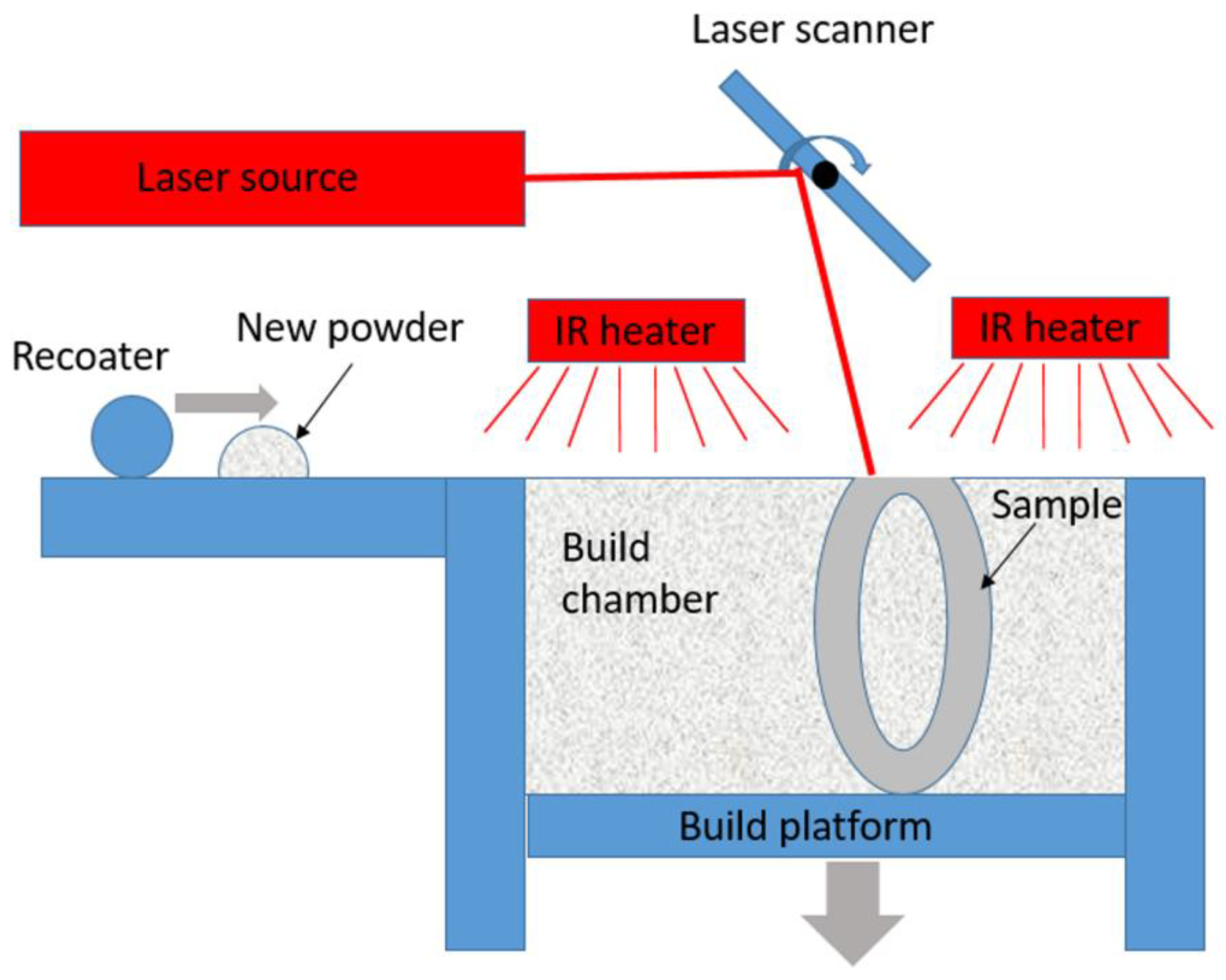
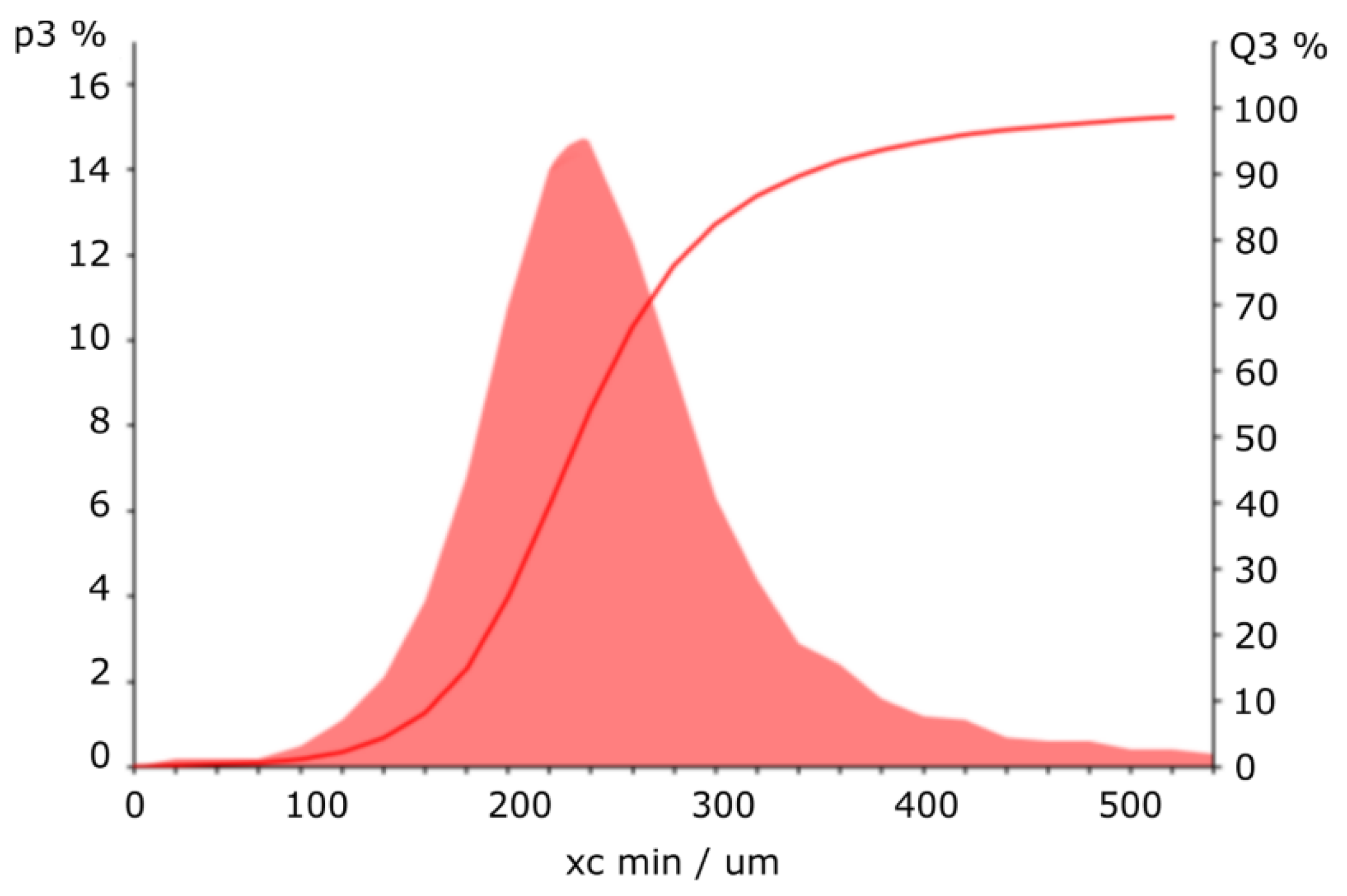
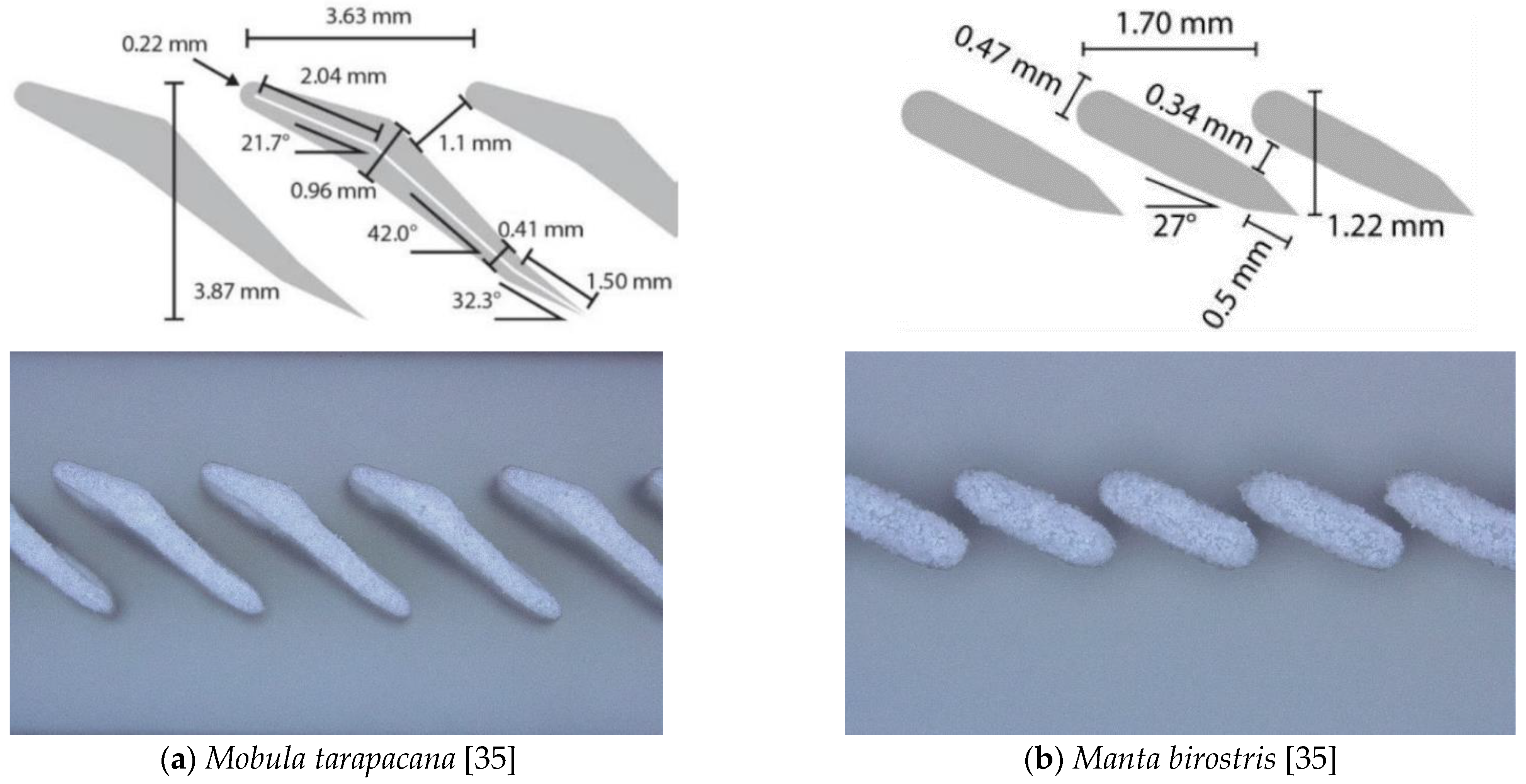
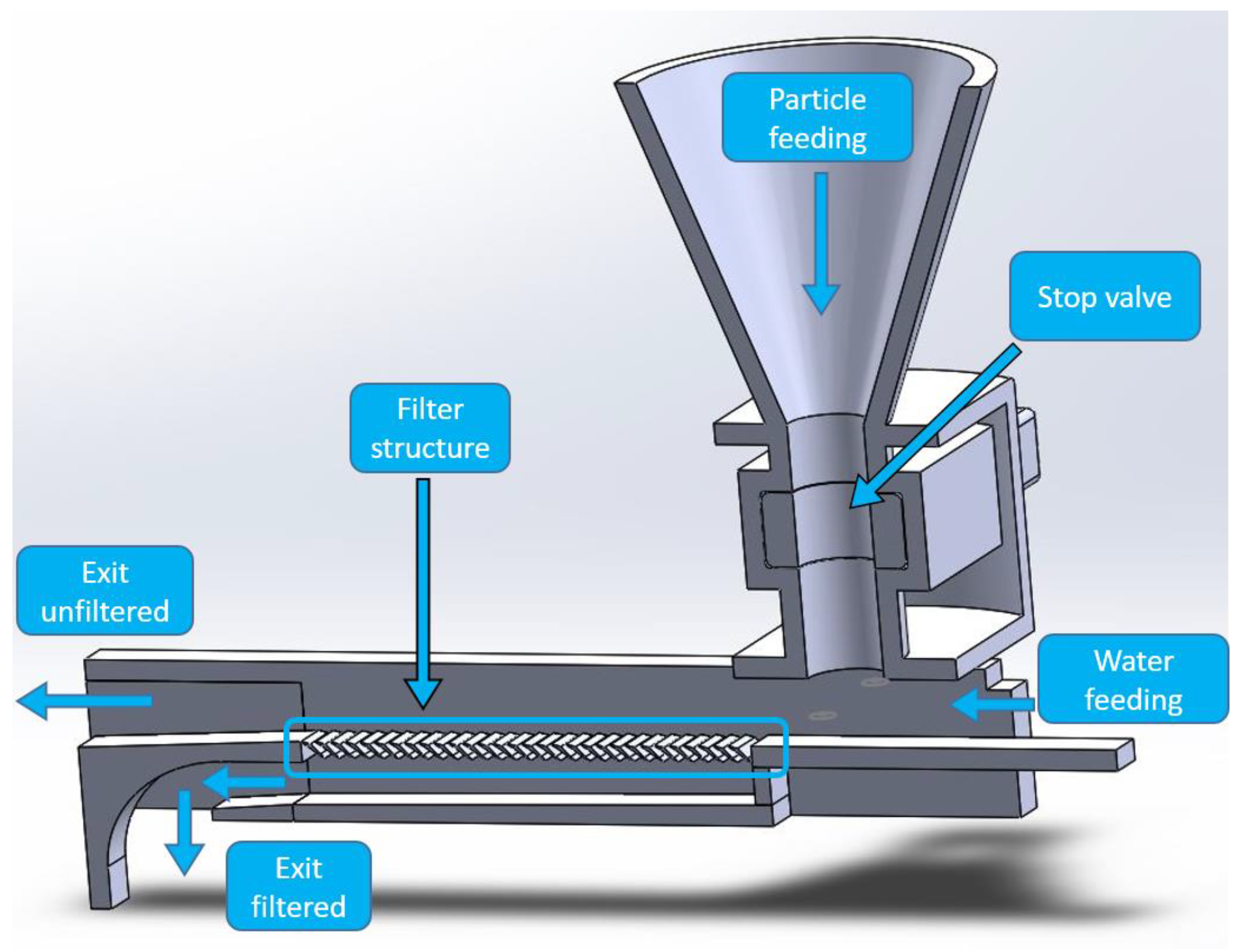


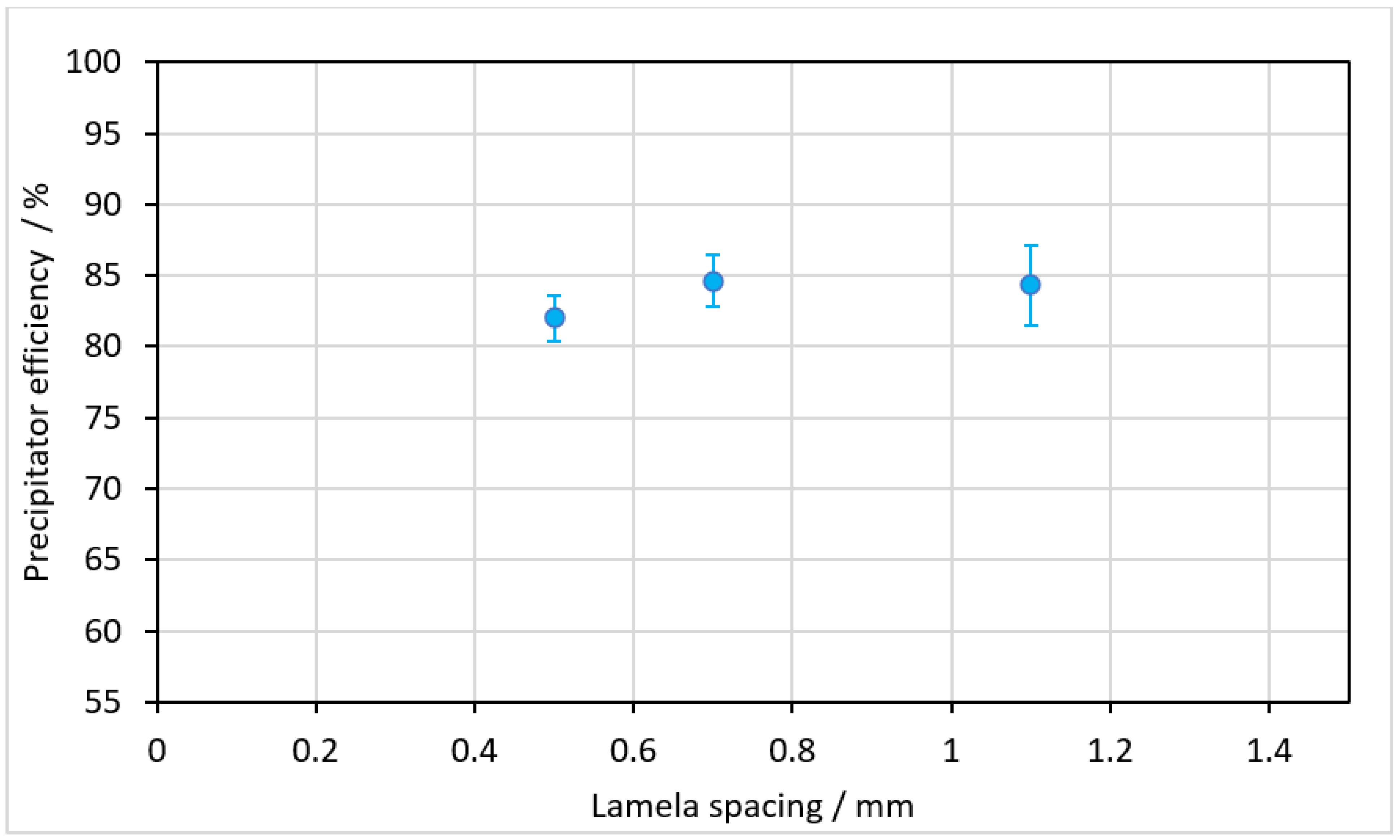
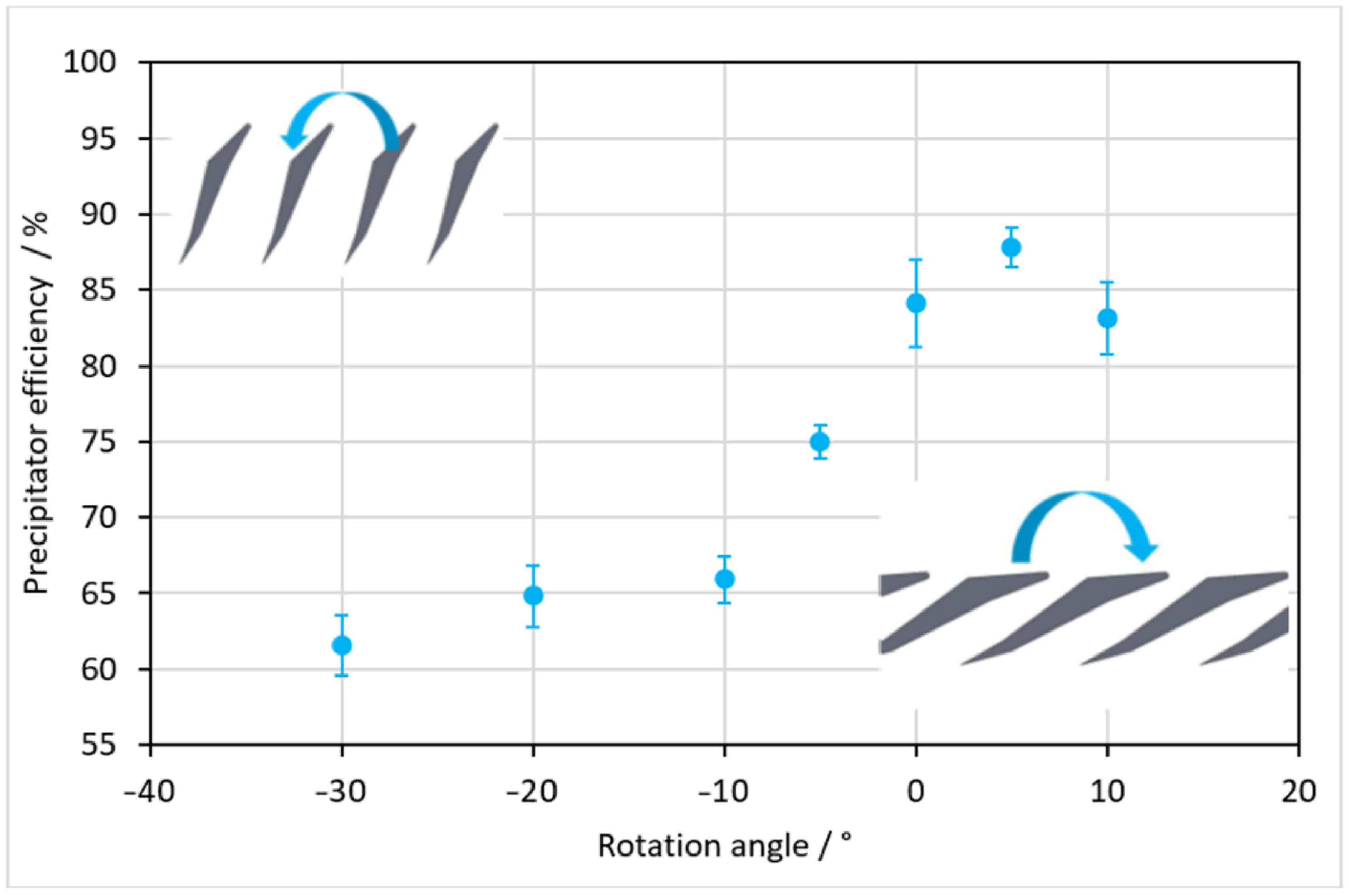
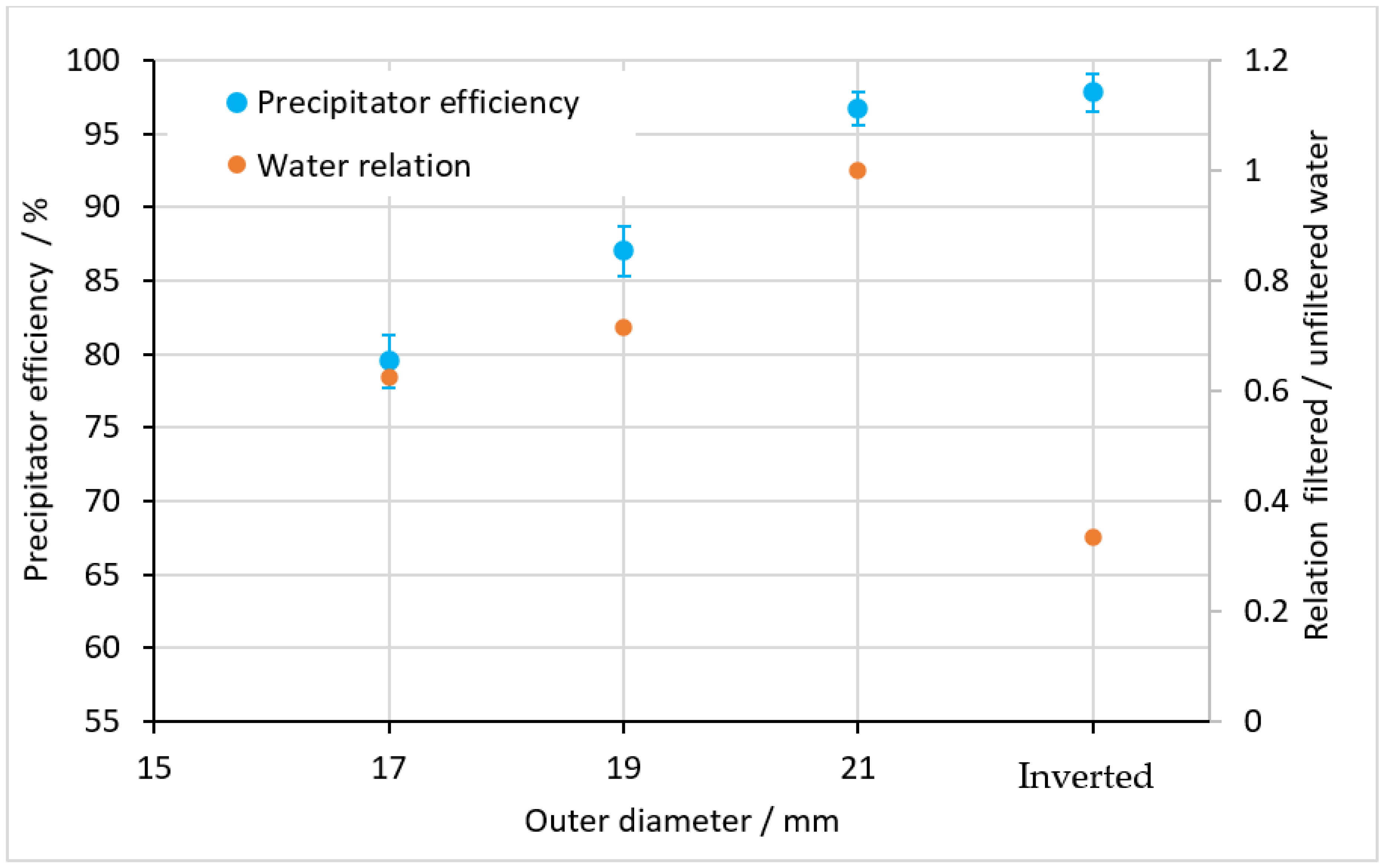
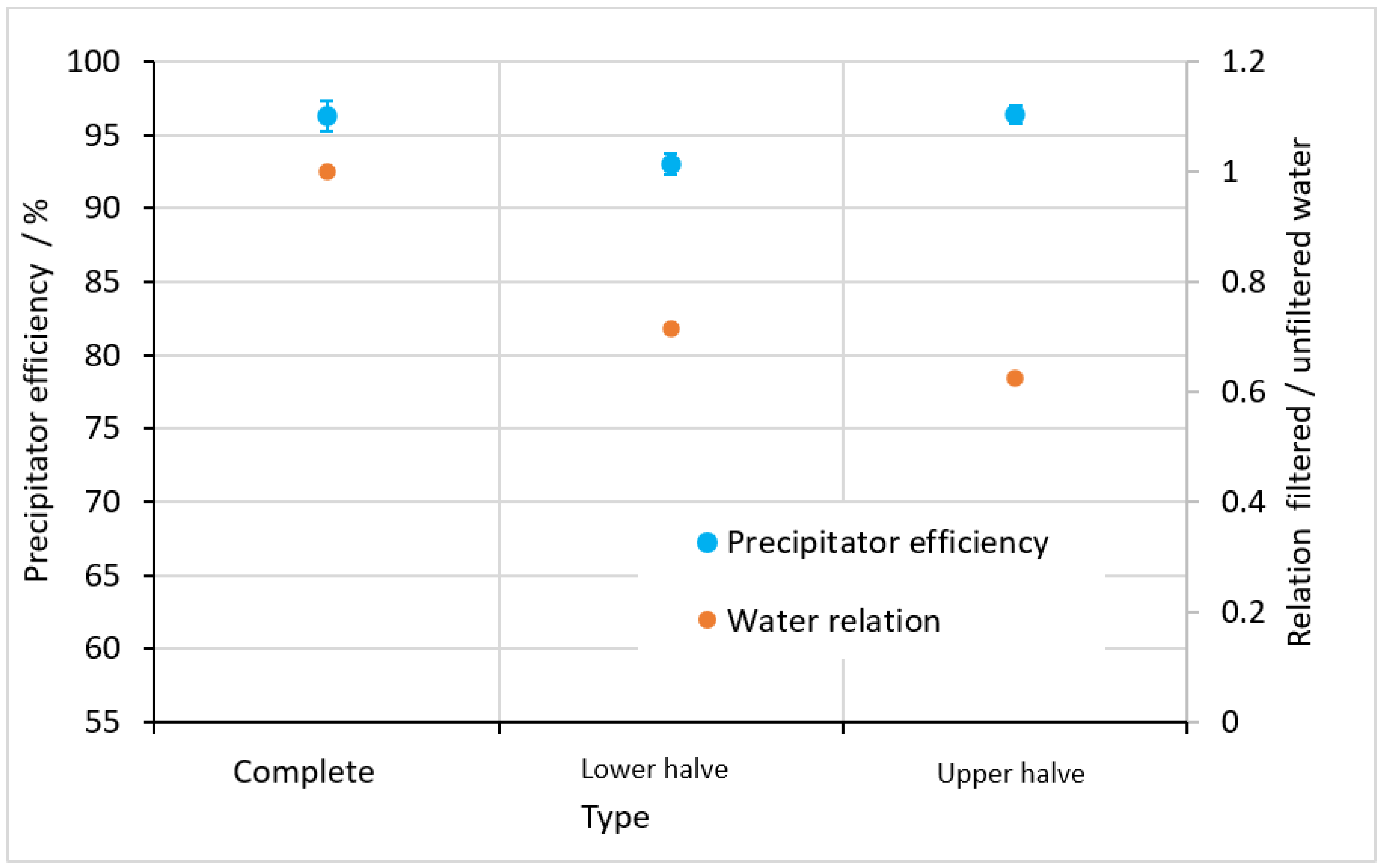
| Name | Scheme | Precipitator Efficiency | Filtered Water Flow |
|---|---|---|---|
| Manta Spoiler |  | 93.2 ± 0.98 | Low |
| Manta Wing |  | 99.3 ± 0.47 | Medium |
| Mobula Spoiler |  | 91.5 ± 0.84 | High |
| Mobula Wing |  | 0 | High |
| Filter Type | Q 10%/µm | Q 50%/µm | Q 90%/µm |
|---|---|---|---|
| Before filter | 166 | 233 | 343 |
| Flat filter mobula “spoiler” | 152 | 215 | 284 |
| Flat filter −30° rotation | 163 | 226 | 304 |
| Round filter 17 mm | 161 | 224 | 303 |
| Round filter 19 mm | 150 | 214 | 283 |
| Round filter 21 mm | 137 | 200 | 263 |
| Round filter inverted | 143 | 204 | 266 |
Publisher’s Note: MDPI stays neutral with regard to jurisdictional claims in published maps and institutional affiliations. |
© 2022 by the authors. Licensee MDPI, Basel, Switzerland. This article is an open access article distributed under the terms and conditions of the Creative Commons Attribution (CC BY) license (https://creativecommons.org/licenses/by/4.0/).
Share and Cite
Adelmann, B.; Schwiddessen, T.; Götzendorfer, B.; Hellmann, R. Evaluation of SLS 3D-Printed Filter Structures Based on Bionic Manta Structures. Materials 2022, 15, 8454. https://doi.org/10.3390/ma15238454
Adelmann B, Schwiddessen T, Götzendorfer B, Hellmann R. Evaluation of SLS 3D-Printed Filter Structures Based on Bionic Manta Structures. Materials. 2022; 15(23):8454. https://doi.org/10.3390/ma15238454
Chicago/Turabian StyleAdelmann, Benedikt, Tobias Schwiddessen, Babette Götzendorfer, and Ralf Hellmann. 2022. "Evaluation of SLS 3D-Printed Filter Structures Based on Bionic Manta Structures" Materials 15, no. 23: 8454. https://doi.org/10.3390/ma15238454
APA StyleAdelmann, B., Schwiddessen, T., Götzendorfer, B., & Hellmann, R. (2022). Evaluation of SLS 3D-Printed Filter Structures Based on Bionic Manta Structures. Materials, 15(23), 8454. https://doi.org/10.3390/ma15238454






